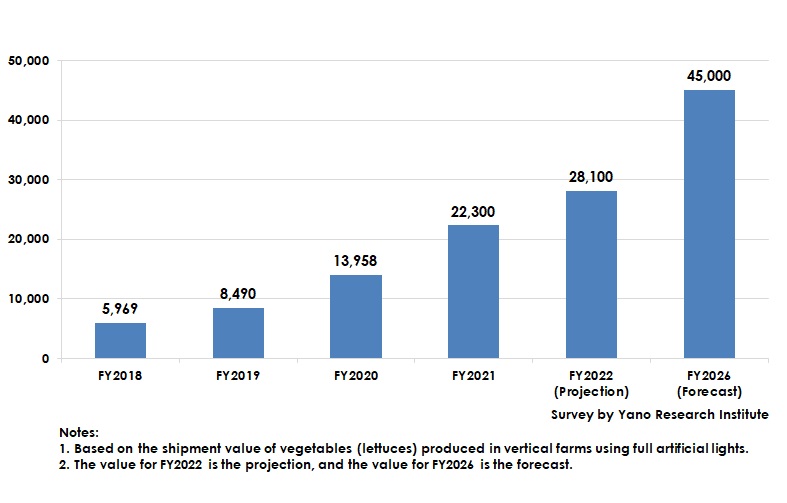No.3038
Vertical Farming Market in Japan: Key Research Findings 2022
Market of Vertical Farming Fully Using Artificial Lights Projected to Grow by 26.0% on YoY for FY2022 Based on Shipment Value at Growers
Yano Research Institute (the President, Takashi Mizukoshi) carried out a survey on the domestic market of vertical farming fully using artificial lights, and found out the current status, the trends of market players, and future outlook.

Market Overview
The domestic operational market size for lettuce grown in vertical farms fully using artificial lights for FY2021 has reached 22,300 million yen, 159.8% of the size of FY2020, based on the shipment values at producers of vertical farming vegetables. The market size is projected to be 28,100 million yen in FY2022, 126.0% of the previous fiscal year.
Since lettuce is expected to account for more than 90% of the crops produced by artificial light-used vertical farms, the market size of lettuce, which accounts for most of the crops grown, was calculated in this document.
Amid the coronavirus crisis, consumer consciousness of food sanity and food safety has remained high. Vegetables grown in vertical farms are highly valued by consumers, because they are sold in packs, making them a clean image, and because they have smaller amounts of bacteria than vegetables grown outdoor.
In addition, in the situation where international unrest is observed, the efforts on food security are increasing, including risk analysis and assessment, such as understanding of agricultural production and food trading statuses, securing or improving of stable supply during normal times, and responding to any unexpected matters. In such circumstances, vegetables grown in vertical farms are attracting attention as a potential solution to the issues mentioned above, because of thorough quality and hygiene management that can stably produce and supply the plants year-round.
When viewing demand by business use or commercial use, the ratio of business use continues to grow. Demand for those vegetables grown in vertical farms is increasing, as some vegetables cut in pieces for ready-to-eat meals that include fresh spring rolls, salads and sides for main dishes at restaurant chains, salads and sandwiches sold at convenience stores, etc. While procurement of vegetables grown outdoors is becoming more difficult year by year due to volatile price fluctuation caused by climate changes and abnormal weather, business users value vertical-farm-grown vegetables produced in sealed, weather-proof environments because of stable availability, price and quality.
Noteworthy Topics
New Items to Grow: Planning for Leaf Vegetables, Strawberries, Spinaches, etc.
Vertical farms fully using artificial lights enjoy stable demand throughout the year. Lettuce production is the mainstream, due to the lower amount of light (radiation) needed and easier to grow than fruit vegetables. Meanwhile, production of other high value added, promising plants has been groped for, such as strawberries and spinaches.
Strawberries have weakness in heat, so that the shipment volume significantly differs by season. On the other hand, demand for strawberries is strong all year round for cakes and confectionery. In the hot summer, demand for strawberries tends to be met by importing from overseas. Traditionally, growing strawberries under full artificial lights used to have faced high hurdles such as profitability issues. In recent years, however, improvement in LED technologies together with the progress in studies on fruit vegetable cultivations has increased the number of businesses entering strawberry production.
Large-scale spinach production projects have manifested. It is expected that more companies will enter spinach production in vertical farms to produce frozen spinach, not to mention fresh spinach.
Future Outlook
Beyond lettuce, vertical farming is expected to expand to crops such as kale, spinach, herbs, and strawberries.
The vertical farming market is projected to continue expanding, as evidenced by proactive business projects being underway by vertical farm operators, such as the construction of a new large-scale vertical farm with a production capacity of more than one ton per day. The operating market size for lettuce grown in vertical farms that fully utilize artificial lighting is expected to reach 45,000 million yen by FY2026, based on the shipment values of vertical farm operators.
Research Outline
2.Research Object: Enterprises and R&D institutions participating in vertical farming fully using artificial lights
3.Research Methogology: Face-to-face interviews (including online) by specialized researchers, surveys via telephone/email, literature research, and questionnaire
About Full Artificial-Lighting Vertical Farming
Vertical farms fully utilizing artificial lighting are the sealed indoor facilities for growing crops using only artificial lights for light sources and using air conditioning and solution culture. In such vertical farms, crops are grown by controlling the environmental factors needed, such as lights, temperature, humidity, CO2 concentration, etc. This research does not include those vertical farms that use both sunlight and artificial lights, and those that do not use any artificial lights.
* Since lettuce is expected to account for more than 90% of the crops produced by artificial light-used vertical farms, the market size of lettuce, which accounts for most of the crops grown, was calculated in this document.
<Products and Services in the Market>
Vegetables grown by vertical farming, related materials, consulting
Published Report
Contact Us
The copyright and all other rights pertaining to this report belong to Yano Research Institute.
Please contact our PR team when quoting the report contents for the purpose other than media coverage.
Depending on the purpose of using our report, we may ask you to present your sentences for confirmation beforehand.